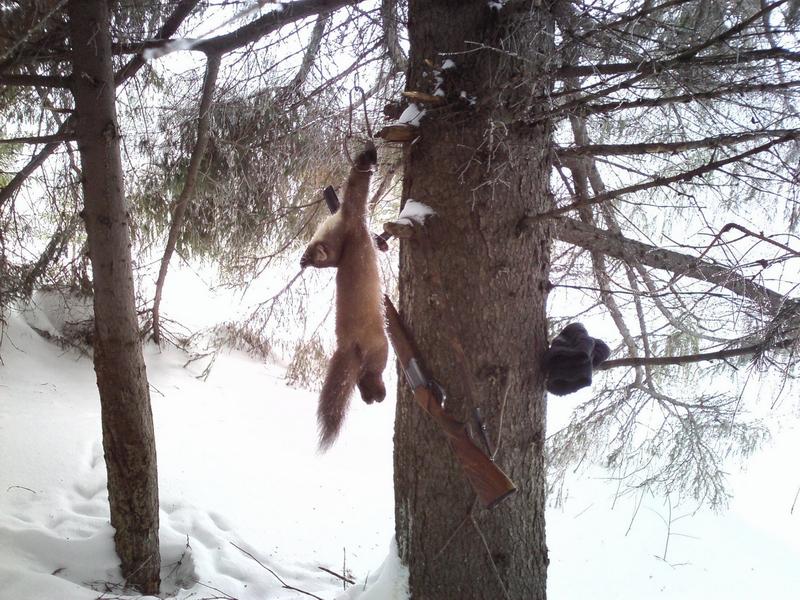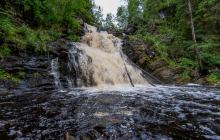The marten is a common fur-bearing animal of the weasel family, the hunt for which is profitable due to the beautiful, expensive and popular fur coat of the animal. The marten is an unpretentious animal, therefore, its residence extends to the entire European territory, in deciduous and mixed forests.
Hunting for marten begins in October-November and lasts the entire winter. At this time, the marten prepares for winter, and its fur becomes thicker and fluffier.
The marten is a very dexterous, intelligent and strong animal, so it is not so easy to hunt for it. The diet of the marten is small birds, rodents, eggs of domestic and wild birds.
Important! Hunting for fur-bearing animals is carried out exclusively under licenses and in ways that are permitted by law.
Popular methods of hunting weasel are the use of traps, traps, hunting for an animal with a dog and a hunting rifle.
Features of hunting using traps
In order to correctly set the traps, it is important to know where the prey lives, its habits, preferences, and behavior in an extreme situation. Experienced hunters know a lot about the lifestyle of the animals they hunt. It helps the hunters a lot.
Before setting traps, you should know a few facts that will help you achieve your goal:
- it is important to know the footprints of the animal: they look like the footprint of a hare. Sometimes the trail is confused with sable. But in the sable, the tracks are more elongated and the jump is shorter;
- it is better to prepare for the hunt in advance, having carefully studied the terrain and marking possible places for the appearance of prey, spreading out complementary foods;
- a distinctive feature of the appearance of animals in a certain place is their droppings. The found droppings on the trees indicate the habitation of children, which means that the adult will return;
- the location of the marten houses is not a permanent habitat of the animal. Only a female with offspring can stay in one place. The marten will leave the place where there is no longer food, therefore it is important to correctly determine the possibility of its habitation in other places. These can be hollows of trees (a favorite place for daytime rest), areas of windbreaks with traces of dead wood in a mature forest, areas of damp lowlands with fallen trees where the river flows, trees thrown across the river;
- before installing, the traps should be grated or boiled in needles to discourage odors and not scare the animal away. Do not store traps near substances that can be toxic when evaporated;
- large traps should not be used, from zero to third is enough;
- when setting traps, you should not mask them strenuously: the marten is not distinguished by fearfulness, and the trap does not scare it away;
- a caught animal can become prey not only for a hunter, but also for nearby predators, therefore, in order to preserve the skin of a caught animal, it is best to use hanging devices;
- in winter, traps can be set on the snow and checked no more than once a week.
In addition to determining the location of the beast, it is important to attract it. For this, bait is used.
Bait
The choice of bait plays an important role in a good hunting outcome. Often carcasses of rodents or birds serve as bait. For a more pungent smell, the carcasses are kept in a sealed bag for up to four days. Then the smell of rotten rot will spread over long distances and attract prey.
Advice! In order to increase the chances of catching a marten, the meat of two different types of animals is used as bait.
Experienced hunters advise sprinkling the bait meat with a little salt to prevent it from freezing. Sometimes marten fishers use honeycomb to attract martens.
Place the bait on a branch, not far from the trap, or over a plate.

Some trappers use anise and nutmeg oils to lubricate the traps.
From how productive the year was, from weather conditions and other natural factors, the preferences of martens change, so one type of bait cannot be dispensed with: one should adapt to the appetite of prey.
Hunters only empirically determine what the mustelids eat, using several different baits at once... What complementary food is most preferable for the marten, such a bait is installed near the trap.
What traps should you use?
Traps are metal devices that have a special spring and a mechanism that is triggered when a trick is pressed. Getting on the device, the prey (or the paw of the animal) is clamped by the metal parts of the device, preventing it from getting out. The principle of action of any trap is to capture prey.
Traps may differ depending on who is being hunted, by the method of attachment, size, power and other indicators.
When hunting with a trap for martens, two types of traps are used:
- frame traps. They look like a stretched canvas on a metal contour. The device is equipped with two springs, a bar and a gate. The arcs spread out on the sides, when the canvas is touched, are slammed, and the prey can no longer get out;
- plate traps. They consist of a metal strip to which arcs are attached. The action of the trap is similar to frame traps.
Kulems (a kind of traps) are also actively used.
Kulems can be installed both on the ground and on a tree. Most often, such traps are placed in a box that protects the trap from snow, and the bait or caught prey from other predators. Kulems are camouflaged with branches and covered with snow more carefully to hide other approaches to the bait.
Regardless of which trap is used, a chain or metal wire must be attached to it, which is fixed to a tree or bush and will not allow the animal to leave with the trap on its leg.

Methods for placing traps
The correct placement of traps is the key to a successful hunt. Hunters have learned to use traps in such a way that the prey in this case is quite good.
Features of the placement of traps:
- so that predators do not catch the prey, it is better to set the trap at the level of human height, and the bait above the trap is 30 centimeters higher;
- traps No. 0, No. 1 are used for hanging, and more for installation on snow;
- it is better to set a trap on the snow on a trodden path, then there are more chances to catch the animal;
- having set the trap on the snow, it is better to cover it with a sheet of paper and lightly sprinkle it with snow. The paper will protect the trap from thawed snow during thaw periods and the trap will not rust. A corroded mechanism may not work;
- so that the snow does not cover the bait, a roof of spruce or other branches is erected over it;
- the trap should be set with the spring outward, that is, opposite the arrival of the animal, firmly fixing the base.
Trap placement options:
- you can place traps in the hollow of a fallen tree so that the bait is in the depth of the hollow, and the trap is at the entrance. At the same time, the hollow can be natural, or it can be independently prepared;
- Another option for installing a trap is to install pegs in a slot made in a tree trunk: two at the top for roofing, one at the bottom for a trap. The pegs should be about 25 cm long. Care should be taken to ensure that the pegs are securely fastened. A wire leash is attached to the peg with a trap, the length of which will allow the animal to be suspended without touching the ground. The distance between the roof and the trap should be about 45 cm. This installation method is performed even before the onset of frost;
- An equally common way of placing traps is in the snow at the place where a dead elk is cut. The insides of the killed cloven-hoofed animal quickly attract the animal. In this case, the leash requires careful fastening so that the marten does not drag the trap behind it.
It is recommended to place traps at a distance of up to 300 meters from one trap to another.... Often, hunters return to the hunting ground, which brought in a lot of prey last season. Complementary feeding in the fall is very important: the marten often appears in places where you can eat. Animals return to their old places. Having determined on the traces of the place where martens pass, you can safely set traps with complementary foods and wait until the fur-bearing animal is caught.
Fur hunting is definitely an exciting activity. Seasoned hunters enjoy not only the result of the hunt, but also the long time spent in nature.



